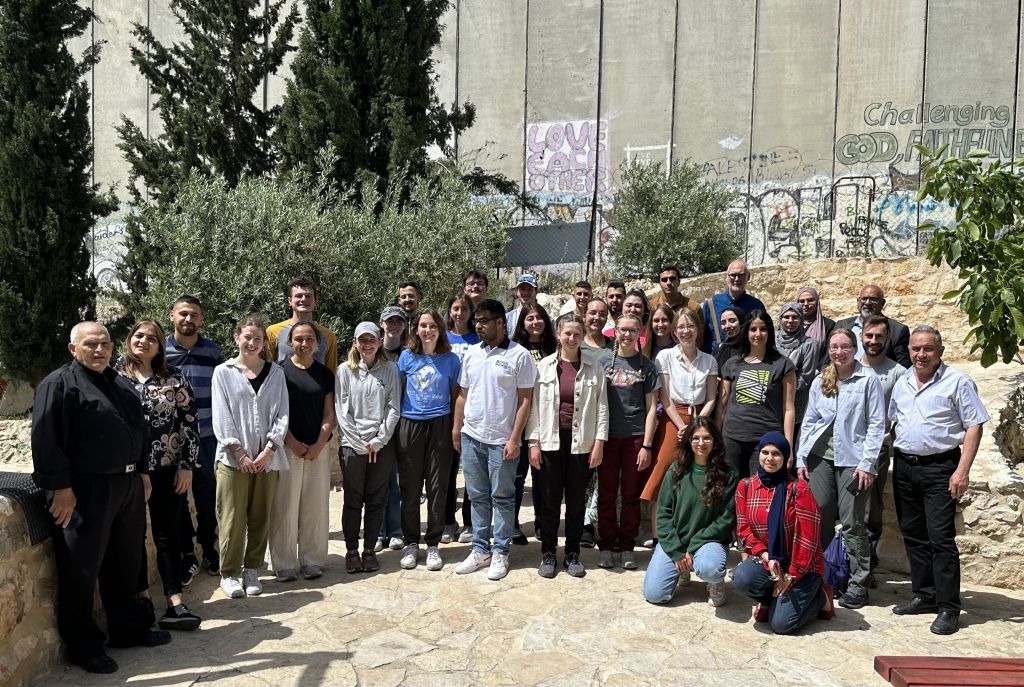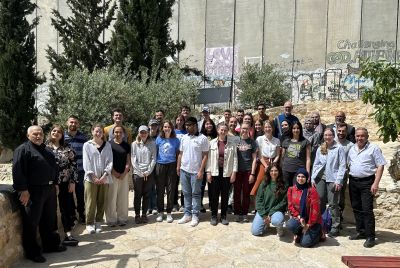“What Does Peace Look Like?”
Emma Gingerich
One Friday afternoon, Zoughbi, the director of the Wi’am Conflict Transformation Center, invited our group to a dialogue with Palestinian “young people.” We had the privilege of sitting in small groups with these young adults, many of whom were either in the work force or in the latter stages of their college studies. We shared experiences: the difficulties of being a young person in the United States and in Palestine, the biggest issues facing our respective countries, the way our societies treat women, and more. Towards the end of my small group’s conversation, I asked a young Palestinian woman what peace looks like to her, in the context of the Israeli occupation. Zoughbi overheard me and said, “save that one for the big group.” So I did. The answers I got were varied, but there were commonalities too. Some of the answers are paraphrased here:
“Peace is to move freely from place to place.”
“Peace is equality and rights for all citizens.”
“Peace looks like the destruction of the wall, the removal of the checkpoints, to have full rights as Palestinians.”
“Peace is to be equipped with hope and to plant it in children, schools, and institutions.”
“Peace is the absence of occupation.”
Perhaps most strikingly, however, one of the young men stated rather matter-of-factly: “It’s hard for me to imagine peace in this land. For Palestinians to have peace, they need to kick Israelis out of the land. For Israelis to have peace, they need to kick Palestinians out of the land. For this, I can’t imagine a pure peace here.”
I have been ruminating on this comment for several reasons, some of which did not become apparent until later in the trip. My initial pondering centered around the question of “pure peace.” The concept feels so abstract, so large, and so unrealistic, to me at least. In an imperfect world, can we really have “purity?” What does pure peace even look like? Is that our goal when we strive for peace, or can we settle for an “impure” peace and be content? I realized another facet of the significance of this comment when we were in the Galilee region. This young man’s comment implies that “coexistence” between Israelis and Palestinians is impossible, and he has no desire for it to become possible. However, we noticed when we were talking to Palestinians living in Nazareth, or other Israeli territories, that some of the people seemed less concerned about maintaining a stark division between Palestinians and Israelis. Maybe they were not as comfortable expressing their true feelings to us as a tourist group; yet it also felt like Palestinians outside of the West Bank are not living with as many daily reminders of occupation. They do not have to stare at an ugly concrete wall when walking down the streets of their city. They do not have to stress daily about whether soldiers are going to let them through a checkpoint to get to their job in a neighboring city. I do not want to speak for all of the experiences of Palestinians living outside of the West Bank, but the contrast was noticeable. Whereas the youth in Bethlehem seemed to emphasize the importance of building connections and strengthening unity between fellow Palestinians and fighting/resisting the Israeli occupation, the Palestinians we talked to in the Galilee region seemed to emphasize building bridges between Israelis and Palestinians.
Our last Monday in Israel/Palestine, we met with Elias Chacour, retired Archbishop of the Melkite Greek Catholic Church. He is Palestinian-Israeli, and he gave us tremendous insight into relations between Palestinians and the Israeli government, especially through stories of his attempts to build a Palestinian/Israeli school in Israel. Chacour emphasized that Israelis and Palestinians are forever bound, their fates linked, and if one group is destroyed, they both will be. His perspective was different than some of the young adults we met in Bethlehem, the more so because he was born in 1939 and witnessed the long trajectory of Israeli occupation, or of the Israeli government’s actions, through his lifetime. Given his longer perspective, hearing his commitment to Israelis and Palestinians working together was unique (though some of his stories also pointed to instances where working together had not proved successful).
I have been struggling with how to hold together the experiences of people in the West Bank with the experiences of Palestinians living in the Galilee. I don’t know what my role is as a person who has never had to choose to be peaceful in the face of life-altering conflict on a daily basis. I don’t know how much of an opinion I am entitled to have in terms of peace building approaches and what peace should look like. I admittedly can’t help but feel a little angry when I hear pushes for cooperation and integration since it can feel like there is no sense of justice. How can someone work with a government, or cooperate with groups of people, that displaced thousands and seized a land as though it were empty? How can we just let oppressive forces “get away with it?” I know, however, that this is a very simplistic way of viewing the situation. Perhaps the need for comfort and solace in “peace” outweighs the satisfaction of delivering some cosmic punishment. Whatever the case, the fight for peace in Israel and Palestine remains messy and deeply multi-faceted, and there are muddied and conflicting perspectives on what peace looks like.






